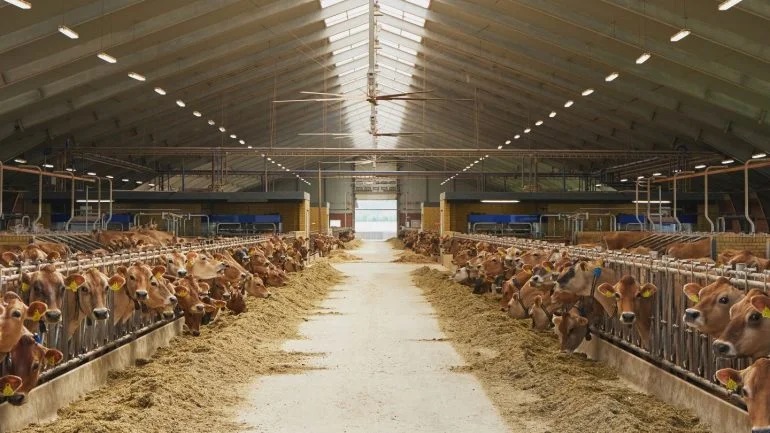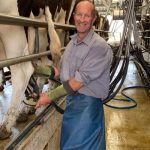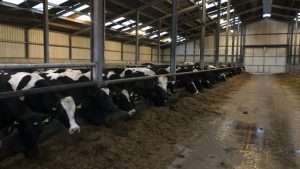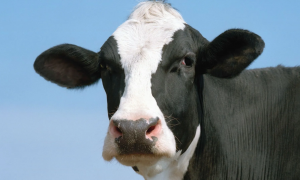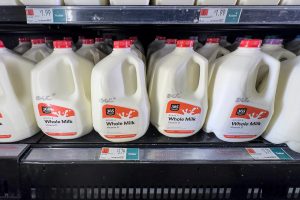
From 2030, Danish farmers will be charged DKr300 ($43) per ton of carbon dioxide (CO2) produced per year.
In late June, Denmark became the first country to announce a tax on livestock emissions. Here, we examine the government’s aims, reaction to the move and its chances of being replicated elsewhere.
What has Denmark done and why?
In an attempt to reduce emissions from livestock, the government, together with farmers, the food industry and environmental groups – the so-called ‘Green Tripartite’ – has put forward a plan to levy farmers.
In its architecture, the tax mimics the CO2 tax imposed on Danish industry sectors in 2022. Thus it is a CO2 equivalent tax (CO2e) including emissions of methane and nitrogen, calculated by their impact equivalent to CO2 emissions.
This approach is intended to avoid the tax being very high due to the large methane emissions in the sector.
From 2030, farmers will be charged DKr300 ($43) per ton of carbon dioxide (CO2) produced per year, rising to DKr750 per ton of CO2 released five years later.
However, a 60% tax deduction means farmers will effectively pay DKr120 per ton in 2030 and DKr300 from 2035 and there are built-in incentives for farmers to reduce emissions.
These include proceeds from the livestock tax in 2030-31 being returned as a transition support fund to support the industry’s green transition.
The implementation of the plans is contingent on approval from the national parliament, which is expected through a vote next month.
The thinking behind the move is clear. Globally, flatulent livestock – and the poo they produce – contributes 15% of global greenhouse gas emissions each year, according to United Nations estimates. The International Energy Agency notes that agriculture – which covers livestock – was the second-largest source of methane emissions in 2022.
Denmark had more than 15,000 farms with livestock in 2023 and it is suggested that a typical Danish cow produces about 6.6 tons of CO2 equivalent each year.
The country’s government will be hoping its tax will encourage framers to explore solutions that may include giving their cattle feed that is less likely to generate methane emissions or giving up part of their agricultural land for other purposes.
The agreement recommends setting aside around 400,000 hectares of agricultural land for purposes including the creation of 250,000 hectares of new forests.
If approved, the carbon tax is predicted to cut Denmark’s greenhouse gas emissions by 1.8m tonnes of CO2 in 2030. This in turn, the government says, will help it move closer to its 2030 target of slashing emissions by 70% compared to a 1990 baseline.
In a statement, Jacob Jensen, the country’s Minister for Food, Agriculture and Fisheries, said the country was “writing a new chapter in Danish agricultural history” with the latest agreement.
He added: “The world lacks food and climate solutions and Danish agriculture can contribute to both parts, helped by this agreement.”
In terms of how it would be implemented, the statement announcing the livestock tax and wider agreement was less than clear, saying Denmark’s government would convene with the relevant parties to discuss this.
But the Copenhagen Post newspaper pointed out that food security regulations require Danish farmers to report the number and types of animals they raise and these figures could be used to calculate methane emissions.
How has Denmark’s agri-food industry responded?
The response has been mixed, it is fair to say. The Council of Food & Agriculture and the farm workers’ union NNF were party to the agreement.
But the organisation Baerdygtigt Landbrug – which translates as Sustainable Agriculture – was not and it is highly critical of the plan.
We believe that the agreement is pure bureaucracy that is unnecessary
Peter Kiær, Baerdygtigt Landbrug
In a statement, it said: “Sustainable Agriculture believes that it is a sad agreement for agriculture, for the climate and for food security.
“Danish farmers become part of a frightening experiment that no other country has tried.”
Its chairman Peter Kiær said: “We believe that the agreement is pure bureaucracy that is unnecessary. We recognise that there is a climate problem and Danish agriculture wants to help solve it, but we do not believe that this agreement will solve the problems because it will put a spanner in the works on agriculture’s green investments.”
He is concerned the setting aside of around 400,000 hectares of agricultural land will have consequences for the individual farmer and affect Danish food production levels.
Kiær added: “It was not long ago that our prime minister articulated the importance of food security. Therefore, it makes absolutely no sense that we should reduce Danish production. At the same time, Danish farmers are among the best at producing climate-efficient food and we must be able to continue to do so.”
Perhaps the most anticipated response to the announcement was that of Arla Foods, Denmark’s largest dairy business and a major player in the sector globally.
Its CEO Peder Tuborgh suggested that legislation of this kind may not be the right way to go unless it only taxes emissions a farmer can control.
“We are convinced that we can achieve our climate goals through voluntary measures. We have a clear plan for this, and we are delivering on it,” he said.
“Over the past two years, we have reduced nearly one million tons of CO2 across Arla Foods – through our own initiatives and with the help of data, advice, and financial incentives. Depending on the exact calculation, this is a significant portion of the shortfall that the entire Danish agriculture sector needs to deliver by 2030. In Denmark alone, we have reduced by 0.21 million tons over the past two years.”
It is essential that the tax base for a CO2 tax is solely based on emissions for which there are means to eliminate
Peder Tuborgh, Arla Foods
Tuborgh went on: “Our farmers are already engaged in the green transition. Arla has created a financial sustainability supplement model to support our farmers in reducing their farm’s climate footprint. In short, the more climate and sustainability measures an Arla farmer implements, the more they are paid for their milk. Every single year, we conduct climate checks on all farms, a model that has now spread to the rest of the dairy sector.
“It is crucial for us that farmers who genuinely do everything they can to reduce their emissions are not subjected to a tax now or in the future. Therefore, it is essential that the tax base for a CO2 tax is solely based on emissions for which there are means to eliminate.”
While applauding the move, Kristian Hundebøll, CEO of DLG Group, a cooperative owned by 25,000 Danish farmers, is keen to ensure that this is not a Denmark-only initiative.
He said: “It is crucial for the competitiveness that the tax is anchored in Europe, because neither the climate, agriculture nor the ancillary industries benefit from Denmark acting unilaterally. Therefore, I am also pleased that the agreement states that we must work for a common European solution and, at the same time, a growth plan is set to be implemented to secure our position as one of the world’s leading countries within food production.
“The agreement provides the necessary time for us to deliver the technology and the transition that we, in the industry, believe is feasible. We have to prove that we put action behind the words.”
What are other interested parties saying?
Denmark’s livestock tax has been well received, as might be expected, by environmental campaign groups and like-minded academics.
Mark Howden, director of the Institute for Climate, Energy and Disaster Solutions, Australian National University and a member of the Expert Panel on Livestock Methane suggested the move should act as an example for other nations to follow.
“The world can no longer afford to ignore the third of global emissions produced by the agri-food sector”, he said.
“The solutions needed to make a significant cut in agriculture’s climate footprint already exist – but financial incentives like the Danish tax could assist them being implemented at scale.
“This policy package looks like it can push down on greenhouse gas emissions efficiently at the same time as generating benefits for farmers and for biodiversity. Recirculating the proceeds of the tax into a transition support fund for the farm sector, if handled strategically with an appropriate research and development component, could generate a new wave of innovation and new opportunities.”
Similarly, Martin Lines, UK-based CEO of the Nature Friendly Farming Network, is keen on the idea. He said: “Agriculture can and must play a significant role in reducing its own emissions and has the potential to sequester carbon for others. A carbon tax should be implemented across all industries, with agriculture taking an active part not only in emission reduction but also in leveraging the opportunities to be rewarded for carbon sequestration.”
And Nusa Urbancic, CEO of Netherlands-based environmental campaign group Changing Markets Foundation, is equally enthusiastic about the Danish initiative, although she noted New Zealand’s recent decision to postpone a similar plan
She said: “It’s great that Denmark is leading the way in pricing farming emissions to ensure that its highest emitting sector contributes to green transition. However, when it comes to reducing emissions from agriculture, farm lobbies around the world consistently ensure that one step forward is followed by two steps back.
“We’re already witnessing a similar backlash against Denmark’s carbon tax, with critics arguing it stifles technology investment and is unfair to farmers. Danish governments – and governments worldwide – must stand firm against these tactics, take urgent action to regulate the industry, reduce emissions and invest in alternatives.”
Is Denmark’s livestock tax likely to be replicated in other countries?
New Zealand presented a plan to charge agricultural farmers for their greenhouse gas emissions in 2022.
The proposal, which looked to reduce methane and nitrous oxide emissions, received heavy criticism at the time from the country’s farmers’ federation, Federated Farmers of New Zealand.
Reports earlier this month revealed the centre-right coalition government, elected last November, intended to scrap such plans.
Urbancic at Changing Markets Foundation said: “New Zealand is a clear example of powerful special interests derailing climate action at the expense of taxpayers. Despite the fact that livestock farming is responsible for half of the country’s emissions, New Zealand’s farm lobby successfully delayed any attempts to price or reduce its emissions for over 20 years.”
Meanwhile. The UK’s Financial Times newspaper reported that the European Commission is studying how it could set up an EU-wide agricultural emissions trading system, looking at options including requiring farmers and landowners to pay directly for their emissions.
It said that at an event held in Brussels last week, Alexandre Paquot, deputy director-general of the EC’s climate arm, said bringing agriculture into the bloc’s emissions trading system should present a “new business case and new opportunities for farmers”.
In February, the EU was criticised for including concessions for the agri-food industry in its newly-released emissions reduction target.
The European Commission laid out plans to cut greenhouse emissions by 90% by 2040 as part of its aim to become the world’s first climate-neutral continent.
But environmental groups were angry the final document no longer referred to cutting agricultural emissions of methane.
As far as the US is concerned, the country was a signatory to the Global Methane Pledge at the environmental summit COP26 but a methane tax may be a step too far, certainly at this stage.
Asked by Just Food whether he thought such a tax could be introduced in the US, Jaime Castaneda, executive vice president, policy development and strategy, at the US Dairy Export Council, said: “No, I don’t think so. The US, unlike Europe is promoting efficiencies, productivity and innovative tools – feed additives – to reduce emissions rather than lower number of animals or taxing farmers.”
But whether they follow Denmark’s plan to tax livestock emissions or not, other countries or blocs of countries will be keeping a close on what happens.
Whether Denmark’s moves will shape their own future carbon reduction initiatives remains to be seen but, many observers will point out that, when it comes to such an important environmental issue, inactivity is not an option.
You can now read the most important #news on #eDairyNews #Whatsapp channels!!!
🇺🇸 eDairy News INGLÊS: https://whatsapp.com/channel/0029VaKsjzGDTkJyIN6hcP1K
